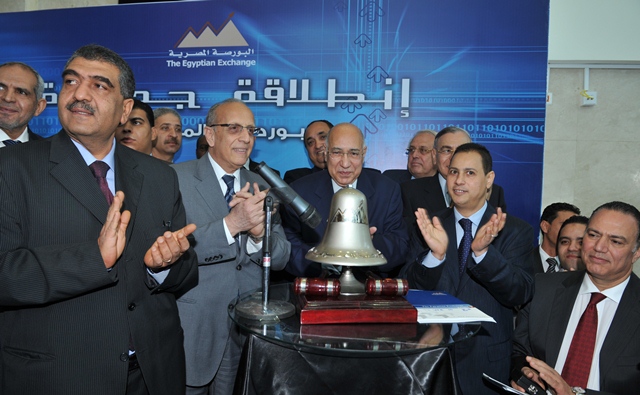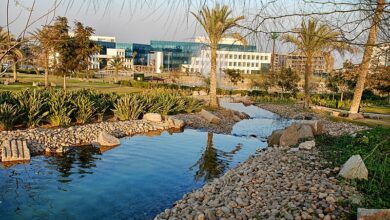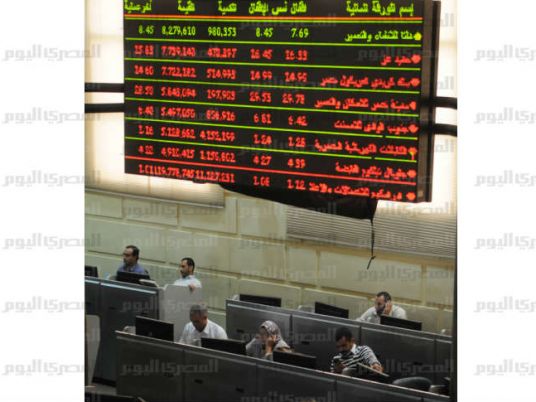
When officials cut the ribbon in front of the doors of the new headquarters for the Egyptian Exchange on 12 April in the “Smart Village” and stepped inside the new, marble-floored building, they claimed they were taking a step towards a new, more technologically advanced, and better economy for Egypt.
But the move is taking the stock market further geographically from the heart of the city, and also, it seems, further out of the consciousness of the average Egyptian.
“The opening of this new building for the Egyptian Exchange with these remarkable capabilities of the Smart Village is a marriage between the financial and telecommunications sectors, which will encourage increased investment and attract more investors,” Communications and Information Technology Minister Mohamed Salem said during the ceremony to a crowd of selected journalists and businessmen.
Smart Village, a gated community of office buildings, is home to many multinational companies’ Egypt headquarters. Microsoft, IBM, HSBC, Teletech, Vodafone, and the Arab Bank are among the tenants of modern-style office buildings, made of white stucco with matching blue-reflective windows that offer no glimpse of the corporate workings inside.
The new exchange headquarters itself is one of the largest structures, with two buildings connected by a skyway over a road.
The compound itself is a 45-minute drive from the center of Cairo, without traffic. On the day of the opening, gardeners weeded flower beds on the grassy grounds, and a fleet of window washers in red jumpsuits descended the face of the Arab Bank building. Cranes swung on nearby construction sites. The acres-large office compound seemed deserted except for attendees of the opening, maintenance and construction workers.
It’s a stark contrast to the old stock market building, which is nestled in the pedestrian block of Downtown eponymously named “Boursa,” or exchange. A pedestrian area famous for its café culture, in the evenings it fills with young professionals and students smoking shisha and drinking tea.
Cairo’s exchange is one of the oldest in the Middle East, and has been housed downtown since 1928, a year before the Wall Street crash that heralded the beginning of the American Great Depression. An international competition was held to design the headquarters, and won by French architect Raoul Brandon, who also designed the Cairo Orosdi-Back department store. At the time, the Egyptian exchange was ranked fifth in the world, thanks to the country’s booming cotton market.
At the opening, stock market officials said, it would be technology that propelled the Egyptian Exchange to prominence once again.
“It increases the abilities, the infrastructure,” said Amr Allouba, chairman of Engineering Consultants Group, the firm which designed the village, who attended the opening. “You need technology for trading to take place, nowadays,” he said.
Exchange officials have been planning for the exchange to relocate to the village since 2002, he said. He said he thinks international investors will be attracted to the services offered in the “information technology park.”
The move also means that the headquarters will be tens of kilometers from the central Tahrir Square, the symbolic and geographic center of the country’s 18-day uprising last year that led to former President Mubarak’s resignation.
In the past year, downtown, which is also home to the People’s Assembly, Shura Council, and Ministry of Interior, has become a flashpoint for protest and unrest, which have been a lag on the country’s recovering economy.
Though the move was planned when Mubarak was still firmly and comfortably seated as Egypt’s president and foreign investors are likely to balk at unrest no matter how geographically far it is from the exchange, officials hinted that moving the exchange out of the mercurial downtown might usher in a more stable future for the country’s economy.
“It is our hope that the opening of the new headquarters will begin a new era of economic stability,” Finance Minister Momtaz al-Saeed said at the opening.
The new era, officials said, would be one in which international investors would return to Egypt, investing like they did before Mubarak’s departure. But continuing with a policy of catering to deep foreign pockets at the expense of the average Egyptian’s needs is a common refrain of critics of the former president and his businessman son, Gamal.
Of the current 150-some companies that trade as members on the Egypt Exchange, many are construction or development companies that helped build the satellite cities, and some, such as Ezz Steel, headed by Ahmed Ezz, a Mubarak crony currently on trial for corruption, have ties to the old regime.
Many Egyptians feel a disconnect with the financial world of the few elite, many of whom live in new suburbs of the city and commute by car to white color jobs.
In the past three decades, the government encouraged expensive construction projects on the city’s periphery, after which downtown was inhabited by people of a lower economic class. Many of the grand turn-of-the-century buildings, like the exchange, fell into disrepair.
The stock market’s relocation, it seems, could be just another representation of the capital flight from the city center, and the politician-businessmen relationship that created Cairo’s peripheral urban development, central decay, and did little to alleviate poverty.
Editor of the privately owned daily Al-Shorouk and economic commentator Wael Gamal touched on this same idea in a March editorial, “If you really want a political economy,” which he wrote for the Arabic language website Jadaliyya. In it, he wrote that over a year after protesters cried for social justice, bread, and an end to the Mubarak regime, the economy “remains the privilege of the few with little advancement in the past year,” with the interim government having made “few decisions worth describing.”
“And so, we’ve seen thick dust gather on important decisions concerning economic aid and sovereignty,” he wrote. “All because of people who defend by tooth and nail their program and their propaganda, and who do not dream of imposing conditions on economic aid, or balancing the public spending, and who give priority to exporters and opening markets and attracting foreign investment.”
Gamal continued his scathing and sarcastic criticism of the current economic powers, lamenting that the rich continue to guard their own interests, at the expense of the poor, whose economic frustration and desire for social justice added gas to the fire of the revolutionaries.
“There is no place for social justice,” he said of the current environment. “Instead, there are general slogans empty of practical depth, or televised announcements the quality of which I am ashamed of when I see poverty, that only bear the warning that the life of the few elite is being threatened (God forbid) by the revolution of the hungry.”
Many Egyptians, like other people around the world who do not have a stake in the high-powered financial world of stocks, bonds, and mutual funds, say they don’t understand how the stock market affects them in their daily lives. Especially in Egypt, where the majority of the economy functions on an informal basis and people avoid banks, don’t have invested pensions, and certainly don’t dabble in trading stocks.
Mostafa Khalil is the new manager of “South Corner,” the café closest to the former exchange headquarters.
He said he personally has no relationship to the stock market, so its move doesn’t matter to him, but that it might have a slight effect on business, with fewer stock exchange workers coming by for shisha.
“In general, I think it is right that to move,” he said. “Because right now whenever anything happens in Tahrir the entire area is shut down.”
Mostafa admitted that, like many Egyptians, he had little understanding of what actually went on inside the exchange, though he said it was important.
“But I don’t know, maybe it’s our own fault, maybe we should know,” he said.




